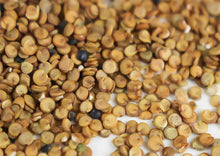Heirloom Orach Purple is a unique, flavorful and nutritious leafy green vegetable that has a long history of cultivation. Originally from the Mediterranean region, this ancient vegetable has been enjoyed for centuries by people all over the world.
The name "orach" comes from the Greek word "arakis," which means "mountain," and it is thought that the vegetable was first grown in the mountainous regions of the Mediterranean. The "heirloom" designation means that this particular variety of orach has been passed down through generations, preserving its unique characteristics and flavor.
Orach Purple is known for its deep purple leaves, which are rich in antioxidants and have a slightly sweet, nutty flavor. It is a versatile vegetable that can be used in a variety of dishes, from salads to sautés to soups. It is also a great source of vitamins and minerals, including Vitamin A, Vitamin C, Iron and Calcium.
One of the best things about Orach Purple is its ability to grow well in a variety of conditions. It thrives in both hot and cold climates, and can be grown in both full sun and partial shade. It is also a hardy plant that is resistant to pests and disease, making it a great choice for any gardener.
Heirloom, Orach Purple, Mediterranean, Ancient vegetable, Nutritious, Leafy green, Flavorful, Nutty, Vitamin A, Vitamin C, Iron, Calcium, Resistant, Pest, Disease, Gardening, Grow, Sun, Shade
Heirloom purple Orach is a beautiful and nutritious addition to any garden or kitchen. If you're looking to add some color and flavor to your meals, give this heirloom variety a try!
Orach also known as Mountain spinach, French spinach, Giant Lambs quarters. Touted as a warm-season alternative to spinach, Orach is actually a cool-season plant that just doesn't go to seed (bolt) as quickly as spinach. Harvest leaves that are less-bitter than spinach into the summer. Purple varieties in particular make good ornamental plants, though can reach 4 to 6 feet tall. Also popular as a micro-green, purple Orach has a deep purple upper leaf with the shimmering underside characteristic to all Orach.
During the middle Ages, Orach was one of the mostly commonly grown vegetables in Eurasia and by the 17th and 18th centuries it had “conquered” the Americas and Australia as well. It is grown in Europe and the northern plains of the United States as a substitute for spinach either fresh or cooked. The flavor is reminiscent of spinach and is often combined with sorrel leaves. The seeds are also edible and a source of vitamin A. They are ground into a meal and mixed with flour for making breads. Seeds are also used to make a blue dye.
Orach is generally disease and garden pest resistant. Occasionally there may be Aphids gathering on the underside of leaves. Use garden hose water to blast off aphids early in the morning. Keep an eye out for the larvae of lady beetles and lacewings. Though not common, you may have to pull a few of them out of the soil occasionally.
Harvest
If the orach plants are tightly spaced, harvest them all the way down to one or two inches above the soil. Once they grow back up, you’re ready to harvest again for fresh salads and greens. If you thinned out your rows up to 12 inches apart early during grow period, you could now choose to thin them up to 18 inches, or you can keep them as they are.
When harvesting from fully grown orach plants, wait until the plant has fully matured, then leave the older leaves in place and begin regularly harvesting the younger leaves so that the orach stays healthy and focused on new growth. Pinch off flower buds to encourage branching and promote new growth.
Click here to download our free vegetable growing guide
Heirloom, Orach Purple, Mediterranean, Ancient vegetable, Nutritious, Leafy green, Flavorful, Nutty, Vitamin A, Vitamin C, Iron, Calcium, Resistant, Pest, Disease, Gardening, Grow, Sun, Shade, Organic, Non-GMO, Nutritious, Versatile, Heirloom variety, Chemical-free, Sustainable, Minerals, Edible leaves, Salad green, Unique taste, Heirloom vegetable, Heirloom gardening, Traditional vegetable, Ancient variety, Nutrition-packed, Culinary potential, Health benefits, antioxidant-rich, Natural farming, Safe to consume, Garden friendly, Kitchen friendly, Healthy food choice, Taste of tradition, Nutritious and delicious, Nutritious leaves, Low maintenance, Easy to grow, Low water requirement, Adaptable to various climates, High yield, Culinary diversity, Nutritional powerhouse.






